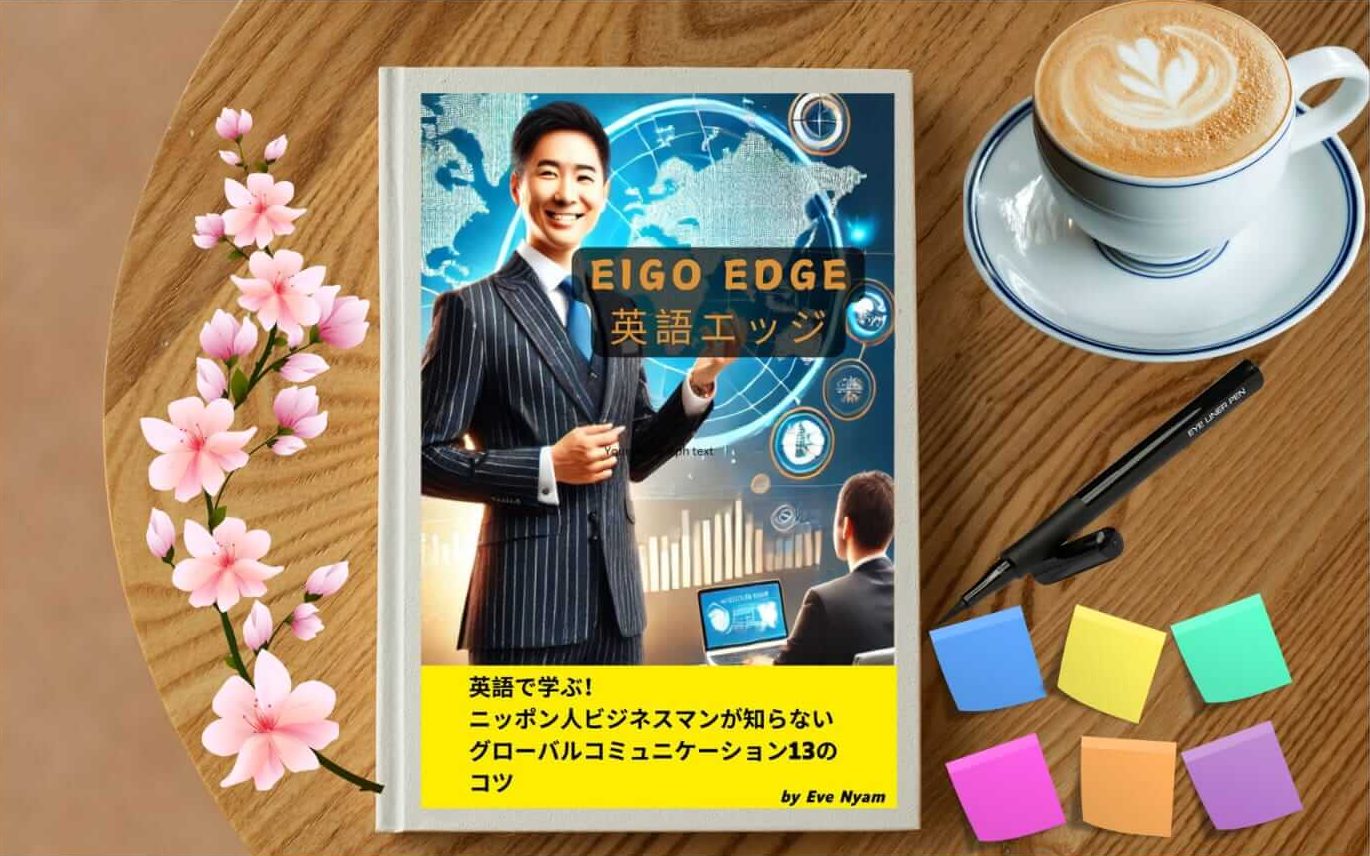「英語は通じているはずなのに、なんだか会話がぎこちない…」
Have you ever had that feeling during a business meeting or email exchange? You’ve spent years learning English, your grammar is correct, and you’ve even memorized all the “right” phrases. But still—something feels off. Maybe your English sounds too formal, too stiff, or just not quite natural. That’s exactly the challenge that this article “Stop Sounding Stiff: How Intermediate Japanese Professionals Can Sound Natural in English” is designed to solve: helping you shed rigid, textbook expressions and speak with genuine, effortless confidence.
Many intermediate-level Japanese business professionals find themselves in this exact situation. The English is technically correct, but it doesn’t feel comfortable, and native speakers may respond with polite nods rather than genuine engagement.
The truth is:
✅ Sounding natural in English isn’t just about accuracy—it’s about flow, tone, and cultural nuance.
✅ The Japanese tendency to value formality and precision often leads to English that feels rigid to native ears.
✅ Small adjustments—like word choice, sentence rhythm, and even how you say “hello”—can make a big difference.
In this article, we’ll break down how intermediate Japanese professionals can shift from stiff to smooth, from textbook English to natural business conversation. You’ll learn:
- What’s making your English sound stiff (and how to fix it)
- Common phrases that feel unnatural to native speakers
- Natural-sounding alternatives for meetings, emails, and small talk
- Real-world examples with before & after comparisons
- Practice techniques you can start today
ここで学ぶことで、「丁寧すぎる英語」から、「自然で信頼される英語」へとレベルアップできます。
So let’s get started. It’s time to stop sounding stiff—and start sounding like you in English.
Why Japanese Professionals Often Sound Too Formal in English
なぜ日本人の英語は「丁寧すぎる」と感じられるのか?
If you’re an intermediate English speaker in the Japanese business world, chances are your English is already polite and grammatically correct. That’s a great start—but “correct” doesn’t always mean “natural.”
Let’s explore why this happens—and how to shift your communication style without losing professionalism.
1.1 The Cultural Contrast: Keigo vs. Casual English
Japanese culture highly values formality. Business conversations often rely on 敬語 (keigo)—structured, respectful, and indirect. It makes sense that many Japanese learners transfer this same level of formality into English.
But here’s the catch:
🚫 In English-speaking business settings, overly formal English can sound distant or even robotic.
✅ Native speakers often use a casual-but-respectful tone, especially in emails, meetings, and daily communication.
Example:
Japanese English (Stiff) | Natural Business English |
“I would appreciate it if you could kindly send me the file.” | “Could you send me the file when you get a chance?” |
“Please be informed that the meeting has been rescheduled.” | “Please be informed that the meeting has been rescheduled.” |
1.2 Direct Translations That Don’t Quite Work
Another challenge comes from translating Japanese phrases directly into English. The structure might be grammatically fine, but the tone often ends up too indirect, too vague, or just not quite right.
Common example:
- 「よろしくお願いします」 → “Thank you in advance” (ok),
but not always necessary—and overused.
More natural:
- “Let me know if you have any questions.”
- “Looking forward to working with you.”
1.3 The Fear of Being Too Casual
Many professionals worry that using more relaxed English will sound unprofessional.
But sounding natural doesn’t mean dropping all formality—it’s about finding the right level for the context.
Think of English formality as a spectrum:
Too stiff → “Kindly confirm your attendance at your earliest convenience.”
Too casual → “Yo, you coming to the meeting?”
✅ Just right → “Let me know if you’ll be joining the meeting.”
🧠 Quick Reflection:
Have you ever written or said something in English and then thought, “That sounded too formal”?
Write down one of those examples, and we’ll revisit it in the next sections with a natural alternative.
Vocabulary Swaps for More Natural English
「正しいけど、ちょっと堅すぎる」英語を、自然に聞こえる表現へアップグレード
So you’ve mastered the grammar. Great! But many Japanese business professionals still rely on overly formal or textbook expressions—ones that feel stiff to native speakers.
Let’s loosen things up with simple vocabulary swaps that make your English sound more confident, friendly, and natural—without losing professionalism.
2.1 Polite but Natural: The Sweet Spot
You don’t need to sound like a native speaker—you just need to sound comfortable and clear. Here’s how to do it:
❌ Too Formal / Textbook | ✅ Natural & Professional |
I would appreciate it if you could… | Could you…? / Would you mind…? |
Please kindly confirm. | Let me know. / Please confirm. |
I hope this email finds you well. | Hope you’re doing well. / Just wanted to follow up. |
Per your request… | As you asked… / As requested… |
I am writing to inform you… | Just a quick note to let you know… |
📝 Tip: Shorter = more natural in English. Don’t be afraid to cut out unnecessary words.
2.2 Upgrade Your Email Language
Business emails are where stiffness loves to hide. Let’s fix that.
Stiff Email Opening:
“Dear Mr. Tanaka,
I hope this message finds you well. I am writing to follow up on our previous discussion regarding the Q2 project.”
Natural Version:
“Hi Mr. Tanaka,
Just following up on our Q2 project discussion—do you have a few minutes this week to talk?”
Same meaning, but the second version is more human and conversational.
2.3 Business Phrases to Drop (or Relax)
Some English phrases are technically correct—but sound overly formal, outdated, or robotic.
Phrase to Reconsider | Natural Alternative |
“At your earliest convenience” | “When you have a moment” / “When you get a chance” |
“I remain at your disposal” | “Let me know if I can help” |
“Enclosed please find…” | “I’ve attached…” |
“Please do not hesitate to contact me” | “Feel free to reach out” |
👀 Note: These stiff phrases are often copied from templates or older English textbooks.
2.4 Bonus: Business Casual Phrases for Small Talk
Let’s not forget that sounding natural also means being able to chat comfortably.
Japanese Business Phrase | Natural English Version |
「お疲れ様です」 | “Hope you’re having a good day” / “How’s everything going?” |
「よろしくお願いします」 | “Looking forward to working with you” / “Let’s keep in touch” |
「お世話になっております」 | “Thanks for all your help” / “Appreciate your support” |
🗣 日本語では当たり前でも、英語でそのまま言うと不自然になる表現に注意。
🔄 Practice Challenge:
Pick 3 phrases you use often in emails or meetings.
Now try replacing them using the chart above.
✨ Small swaps = big difference in how natural you sound.
Now that you’re learning how to sound natural and confident, don’t miss your next power-up:
👉 10 Must-Know English Phrases for Japanese Professionals — a quick-read post packed with real-world expressions plus a free downloadable phrase guide you can keep on hand for meetings, emails, and more.
Level up your English. Download the guide. Own the conversation.
Sound More Natural When Speaking
話し方ひとつで、あなたの印象は大きく変わる
Many Japanese professionals use correct grammar and vocabulary when speaking English—but still sound unnatural to native speakers. Why?
Because how you speak matters just as much as what you say.
This section focuses on the intonation, rhythm, and flow of natural spoken English—and how small adjustments can help you sound more relaxed, confident, and clear in business settings.
3.1 Use Contractions for a Natural Flow
Native English speakers often use contractions naturally in speech. If you avoid them, your English may sound overly formal or robotic.
Examples:
Without Contraction | With Contraction (Natural) |
I am not sure. | I’m not sure |
We will start at 3 p.m. | We’ll start at 3. |
That is a good idea. | That is a good idea. |
🎯 Tip: Don’t overthink it—using contractions is not “lazy English,” it’s normal conversational English.
3.2 Master the Rhythm and Intonation of English
English has a natural “music” to it. Japanese, being a more syllable-timed language, can lead to flat or monotone English delivery.
In English:
- Content words (nouns, verbs, adjectives) are stressed.
- Function words (the, of, to, in) are usually reduced or spoken quickly.
- The tone rises and falls based on emotion, emphasis, or intent.
Example:
“I thought we were meeting at 3, not 2.”
→ Notice the stress on “thought,” “3,” and “2.” This gives the sentence clarity and emotion.
🗣 Try reading the sentence aloud, focusing on stress and pitch variation.
3.3 Use Filler Phrases Naturally (But Wisely)
Native speakers often use fillers like “you know,” “I mean,” “so,” and “actually.” When used strategically, they can make your speech sound more natural and conversational.
Examples:
Stiff | Natural |
“It is difficult to explain.” | “Well, it’s kinda hard to explain, you know?” |
“That is not correct.” | “That is not correct.” |
🔎 Important: Don’t overuse fillers—they should help with flow, not create confusion.
3.4 Avoid Speaking Too Slowly or Too Perfectly
Many intermediate learners speak slowly to avoid mistakes, which is understandable. But too much caution can make speech sound unnatural.
Instead, aim for a moderate pace—allow yourself to speak smoothly, even if it’s not perfect.
✅ Better to say something clearly and naturally, with minor mistakes,
than to sound rehearsed and robotic.
3.5 Practice Tip: Record Yourself Speaking
Choose a short business topic (e.g., introducing yourself in a meeting, explaining a project). Record yourself, then:
- Listen for rhythm, tone, and pauses
- Check where you could use contractions or simplify your phrasing
- Compare with a native speaker version (YouTube clips, podcasts, etc.)
🎧 Recommended Tools:
- Voice Memos (iPhone/Android)
- Audacity (PC/Mac) – free and powerful
- Otter.ai – transcribes your speech for review
✍️ Self-Check:
Try recording this sentence naturally:
“I was going to follow up with you, but I figured I’d check in next week instead.”
→ Can you hear the rhythm? Contractions? Does it sound natural?
In the next section, we’ll apply all of this to real-life business situations—emails, meetings, and conversations—so you can see the transformation from stiff to smooth in action.
From Stiff to Smooth: Real-World Business Scenarios
実際のビジネスシーンで、自然に聞こえる英語を使う方法
So far, we’ve focused on words, tone, and delivery. Now it’s time to put it all into practice.
In this section, we’ll walk through common business situations Japanese professionals face—and show how to transform stiff, overly formal English into clear, confident, and natural expressions.
4.1 Business Email: Making a Request
Typical (Too Formal):
“Dear Ms. Williams,
I hope this message finds you well. I would appreciate it if you could kindly provide the updated proposal at your earliest convenience.”
Natural Alternative:
“Hi Ms. Williams,
Hope you’re doing well. Could you send over the updated proposal when you get a chance? Thanks!”
📌 Why it works:
- Uses natural greetings and contractions
- Keeps tone friendly but respectful
- Shorter, more direct, and easier to process
4.2 In a Meeting: Giving Your Opinion
Stiff Version:
“In my opinion, I believe that we should consider an alternative approach for the current strategy.”
Natural Version:
“I think we might want to look at another approach for this strategy.”
📌 Why it works:
- “I think we might…” sounds more collaborative
- Natural rhythm makes you sound more confident
- Still polite and professional
🗣 日本語で「ちょっと違うかも」と遠慮して言うような時も、英語では “I’m not sure if this is the best way…” のようにソフトに伝えるのが自然。
4.3 Phone Call: Leaving a Voicemail
Stiff:
“Hello, this is Yamada from ABC Corp. I am calling in regard to the meeting schedule. Please contact me back at your earliest convenience.”
Natural:
“Hi, this is Yamada from ABC. Just calling to check in about the meeting schedule. Give me a call when you’re free—thanks!”
🎯 Tip: Voicemails and phone calls are often casual in tone—being too formal can feel distant or overly scripted.
4.4 Networking: Introducing Yourself
Too Textbook:
“Hello. My name is Hiroshi Tanaka. I work for XYZ Company. It is a pleasure to meet you.”
Natural and Friendly:
“Hi, I’m Hiroshi Tanaka—nice to meet you. I’m with XYZ Company. What do you do?”
👥 Building a connection starts with sounding approachable. A warm tone and natural flow make introductions smoother and more memorable.
4.5 Wrapping Up a Presentation
Too Formal:
“That concludes my presentation. Thank you very much for your kind attention.”
Natural Finish:
“That’s it from me—thanks so much for listening. I’m happy to take any questions.”
📌 Still respectful, but more relaxed. You’ll come across as confident and open, rather than stiff or nervous.
💬 Try This:
Choose one of the situations above.
Write or say your “before” (formal) version, then rewrite it using the techniques in this post.
✨ You’re not just “speaking English.” You’re connecting—smoothly, clearly, naturally.
Common Business Phrases That Sound Awkward (And How to Fix Them)
「そのフレーズ、間違ってないけど…ちょっと不自然?」を自然にアップデート
You may be using phrases that are technically correct—but they signal “learner” to native speakers. In this section, we’ll go over the most common ones Japanese professionals use, show you why they sound off, and give you natural alternatives you can use immediately.
5.1 “Please kindly…” and Other Overpolite Phrases
❌ “Please kindly send me the document.”
✅ “Could you send me the document?”
✅ “Would you mind sending the document?”
👉 “Please kindly” feels overly polite and a bit redundant in English. Native speakers almost never say this—even in formal settings.
5.2 “I hope this email finds you well.”
❌ Overused, impersonal
✅ Try these instead:
- “Hope you’re doing well.”
- “Hope everything’s going great on your end.”
- “Just wanted to follow up on…”
💡 Keep it short and warm. Most native speakers skip the formalities and get straight to the point.
5.3 “Do not hesitate to contact me.”
❌ “If you have any questions, do not hesitate to contact me.”
✅ “Let me know if you have any questions.”
✅ “Feel free to reach out if anything’s unclear.”
🗣️ 直訳の「遠慮なくご連絡ください」は英語だと堅く聞こえることが多いです。自然な言い回しの方が印象が良くなります。
5.4 “I would like to confirm…”
❌ “I would like to confirm our meeting tomorrow.”
✅ “Just checking—we’re still on for tomorrow?”
✅ “Quick confirmation: are we still meeting at 3 tomorrow?”
🧠 Use “just” and “quick” to soften the tone and sound more conversational.
5.5 “I am writing to…”
❌ “I am writing to inquire about…”
✅ “Just wanted to ask about…”
✅ “Quick question about…”
📧 Especially in emails, you can usually skip this formal opening and get right to the purpose.
5.6 “Enclosed please find…”
❌ “Enclosed please find the updated file.”
✅ “I’ve attached the updated file.”
✅ “Here’s the updated file we discussed.”
📎 This one’s old-fashioned. Most native speakers wouldn’t use “enclosed” unless they were sending physical mail.
Quick Chart: Instant Fixes
❌ Awkward Phrase | ✅ Natural Alternative |
Please kindly send | Could you send/ Please send |
I hope this email finds you well | Hope you’re doing well |
I would like to ask | Just wanted to ask |
Do not hesitate to contact me | Let me know if you have questions |
I am writing to… | Just reaching out to |
Enclosed please find.. | I’ve attached/ Here’s |
🧠 Practice Tip:
Take a few emails you’ve written recently.
☑ Highlight any of the “awkward” phrases above.
🔁 Rewrite them using the natural alternatives.
✨ You’ll instantly sound more fluent—and more approachable.
Makeovers: Transforming Real Business English into Natural English
ビジネス英語の「ビフォー・アフター」— 一瞬で伝わりやすく、自然に聞こえる表現へ
It’s one thing to learn tips—it’s another to see them in action. This section shows practical makeovers of emails, meeting scripts, and spoken phrases, rewritten with natural, fluent English your clients and colleagues will actually appreciate.
6.1 Email Makeover: Requesting Information
Before (Stiff):
Dear Mr. Johnson,
I hope this message finds you well.
I am writing to request the Q3 sales data.
Please kindly send it at your earliest convenience.
Best regards,
Satoshi Tanaka
After (Natural):
Hi Mr. Johnson,
Hope you’re doing well.
Just checking if you could send over the Q3 sales data when you have a moment.
Thanks so much!
Satoshi
📌 Why it works:
- Gets to the point
- Uses polite but casual tone
- “Just checking if…” softens the request naturally
6.2 Meeting Makeover: Giving Your Input
Before:
“In my opinion, we should reconsider our marketing approach to better target the younger demographic.”
After:
“I think we might want to rethink our marketing—maybe focus more on younger customers.”
🎯 Tone check: The natural version still shows leadership—but sounds more like a colleague than a textbook.
6.3 Presentation Wrap-Up
Before:
“That concludes my presentation.
Thank you for your kind attention.
I am happy to answer any questions you may have.”
After:
“That’s it from me—thanks so much for listening.
Happy to take any questions you have.”
🗣️ 自然さと自信を両立させるには、あまり形式張らず、相手に話しかけるようなトーンがベスト。
6.4 Phone Call Script: Following Up
Before:
“Hello, this is Keiko from Nippon Tech.
I am calling regarding the quotation I sent last week.
Please contact me back at your convenience.”
After:
“Hi, this is Keiko from Nippon Tech.
Just following up on the quote I sent last week.
Give me a call if you have any questions—thanks!”
☎️ Simple language = clearer message + more trust.
6.5 Team Chat Message (Internal Communication)
Before:
“Dear colleagues,
I would like to inform you that today’s meeting has been postponed due to unforeseen circumstances.”
After:
“Hey team—today’s meeting is postponed. I’ll send a new schedule soon.”
💬 Professional doesn’t have to mean formal—especially on Slack, Teams, or internal emails.
🛠️ Try-It-Yourself Exercise:
Choose one email, message, or script you’ve written recently.
Rewrite it using these principles:
- Use contractions
- Soften overly formal phrases
- Choose direct, clear words
- Speak like a real person
✨ This small habit will transform how your English feels—to you and to others.
In the final section, we’ll wrap up with a practical checklist and action plan for applying these techniques in your daily business life.
Sound Natural, Speak Confidently: Your Action Plan
明日から実践できる!ナチュラルなビジネス英語へのステップ
Now that you’ve seen what natural English looks like, it’s time to build a system that helps you use it consistently—without sounding forced or losing your professional tone.
This final section gives you tools, habits, and a checklist to keep you sounding fluent and confident in every business situation.
7.1 Build a Daily Micro-Practice Habit
✅ You don’t need to study for hours. Just 5–10 minutes a day can bring major improvements.
Try this mini routine:
- ✍️ Write 1 short business email or message
- 🗣️ Read it out loud, naturally
- 🔁 Rewrite it using contractions, tone, and simpler phrasing
- 📲 Record yourself saying it and listen back
🎧 Bonus: Shadow 1–2 minutes of a business podcast or YouTube clip. Focus on rhythm and tone, not just words.
7.2 Create Your “Natural English Swap List”
Start a list like the ones mentioned above in this article in your notebook, Notes app, or Google Doc:
🧠 Use it whenever you’re unsure—and keep adding to it as you learn!
7.3 Internalize with Output, Not Just Input
Reading and listening are important. But real improvement comes from speaking and writing.
📌 Natural English isn’t just memorized—it’s practiced and repeated until it feels like your own voice.
💬 Challenge: Start replying to emails using only natural phrasing for 1 full week. Even one sentence at a time helps.
7.4 Use Tools to Track and Improve
- Grammarly (with tone suggestions)
- QuillBot (for rewording stiff writing)
- Otter.ai (record + transcribe your spoken English)
- HelloTalk or HiNative (ask native speakers for feedback)
👀 Don’t just trust your eyes—listen to how you sound. English is a spoken language, after all.
✅ Final Checklist: “Am I Sounding Natural?”
Before you hit send or speak up, ask yourself:
- Am I using contractions where natural?
- Does this sound like something a native speaker would actually say?
- Am I being too formal or robotic?
- Could I simplify this sentence or phrase?
- Does it flow the way I’d say it in Japanese—if I were speaking naturally?
🔁 Review. Rewrite. Repeat. Your natural English voice is already inside—you’re just unlocking it.
🎯 Wrap-Up: You’re Not Just Learning English—You’re Owning It
Being “intermediate” doesn’t mean you’re stuck in the middle. It means you’ve built the foundation—and now, you’re stepping into mastery.
Small upgrades lead to big confidence. Keep the flow, keep the feeling, and most of all—keep it natural.
お疲れ様でした!👏
Here’s to your next meeting, next email, next presentation—spoken with clarity, confidence, and your own unique business style.
Final Thoughts: It’s Your Time to Sound Natural, Confident, and Clear
Mastering the art of natural English communication takes time and practice, but the rewards are immense. Whether you’re preparing for a presentation, drafting an important email, or simply participating in a meeting, sounding confident and approachable can make all the difference. The key to success is to keep practicing, stay consistent, and challenge yourself to step out of your comfort zone.
You’re not just learning English—you’re mastering the language of international business. And that’s a game changer.
Take Action Now!
- Want to continue your journey to sounding natural in English? Grab your copy of my book, Eigo Edge which dives deeper into practical business English for Japanese professionals like you. It’s packed with tips, exercises, and examples that’ll help you speak with confidence and ease. [Buy Now]
- Stay ahead in your English learning—subscribe to my newsletter at the bottom of this page for more tips, resources, and exclusive offers straight to your inbox.
- Enjoyed this post? – If this helped you feel one step closer to sounding natural and confident in English, there’s more where that came from. Explore our blog for practical tips, real-life phrases, and cultural insights—all designed specifically for Japanese business professionals.
- 👉 [Browse more articles here] and keep leveling up your English.
By focusing on making small, consistent changes to how you speak and write in English, you’ll feel more confident, connect more easily with your international colleagues, and take your professional communication to the next level.
Let’s make this your year to shine in English!



